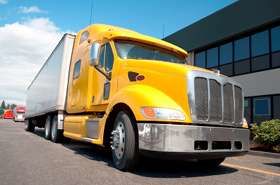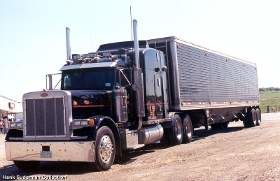Signs, Signs... Everywhere Signs!
Topic 12890 | Page 1

Old school I have something to add read the hole sign, and understand. I have had students miss an important sign for trucks because they just skimmed it or did not pay attention to it. Such as all trucks use left or center lane. And all trucks must stop brake check area. I even had one run a stop sign at a weight station, that was fun. So read and understand.

I loved this post. The information here especially applies to my schooling. I was on the road getting drive time with three other students. Another student was driving. He turned on a road and halfway down it the instructor said "You just passed a sign. Do you know what it said?" the student replied "Uhhhh.... no sir which one?" the instructor answered "The one with the picture of trucks on it with numbers beside them." The student replied "I didn't notice it." The instructor replied "Those numbers were weight limits, and in the middle it said the the weight limit for combination vehicles with one trailer is 26,000 pounds. The student asked "Do you want me to turn back?" and the instructor replied "No, you are good. Keep going."
Same instructor, different student (again, not me). Shortly after turning on a road the instructor asked "What's the speed limit on this road?" the student replied "45." The instructor asked "Are you sure? We just passed a sign for it back there." the student replied "No sir, I'm not sure." The instructor told him that the speed limit had dropped to 40 and asked the student to drop a gear and slow down. The instructor went on to say that in the real world the student would have got himself a ticket for speeding had he been caught, but since the student was still in school the most an officer could issue (in our state at least) is a warning for the student, and the instructor would have been sited had he not have told the student to slow down.
By the way Old School, is that last picture of the famous Massachusetts low bridge that I keep hearing about? Just curious.
Combination Vehicle:
A vehicle with two separate parts - the power unit (tractor) and the trailer. Tractor-trailers are considered combination vehicles.
HOS:
Hours Of Service
HOS refers to the logbook hours of service regulations.By the way Old School, is that last picture of the famous Massachusetts low bridge that I keep hearing about? Just curious.
No, that one is in Cressona, Pennsylvania. It is right down the street from the very large SAPA plant in that town. It is on the route to get to the plant, which has a lot of truck traffic. There is a designated truck route that gets you around that bridge so that you can get in there. The leading edge of that bridge is all scarred up from the many times it has been hit. I was sitting in a cafe just down the street from that bridge just last week when I saw a truck headed for it. What's funny is that there are at least six different signs leading up to the final left turn that a truck will make before heading into that street. They are all very large, and clearly marked telling you that you have to turn right ahead to avoid the low bridge. I was amazed that the driver either ignored or missed all those signs. About five minutes later when he had gotten around a curve which put him out of my sight I started seeing cars putting on their brakes and then the traffic all came to an abrupt halt for about twenty minutes. I couldn't see what was happening down at the bridge, but pretty soon the traffic started moving and here he came headed back in my direction. I guess he finally saw something that gave him a good reason to try and get it turned around.
SAP:
Substance Abuse Professional
The Substance Abuse Professional (SAP) is a person who evaluates employees who have violated a DOT drug and alcohol program regulation and makes recommendations concerning education, treatment, follow-up testing, and aftercare.
HOS:
Hours Of Service
HOS refers to the logbook hours of service regulations.
By the way Old School, is that last picture of the famous Massachusetts low bridge that I keep hearing about? Just curious.
No, that one is in Cressona, Pennsylvania. It is right down the street from the very large SAPA plant in that town. It is on the route to get to the plant, which has a lot of truck traffic. There is a designated truck route that gets you around that bridge so that you can get in there. The leading edge of that bridge is all scarred up from the many times it has been hit. I was sitting in a cafe just down the street from that bridge just last week when I saw a truck headed for it. What's funny is that there are at least six different signs leading up to the final left turn that a truck will make before heading into that street. They are all very large, and clearly marked telling you that you have to turn right ahead to avoid the low bridge. I was amazed that the driver either ignored or missed all those signs. About five minutes later when he had gotten around a curve which put him out of my sight I started seeing cars putting on their brakes and then the traffic all came to an abrupt halt for about twenty minutes. I couldn't see what was happening down at the bridge, but pretty soon the traffic started moving and here he came headed back in my direction. I guess he finally saw something that gave him a good reason to try and get it turned around.
On PA 183 before 901.
SAP:
Substance Abuse Professional
The Substance Abuse Professional (SAP) is a person who evaluates employees who have violated a DOT drug and alcohol program regulation and makes recommendations concerning education, treatment, follow-up testing, and aftercare.
HOS:
Hours Of Service
HOS refers to the logbook hours of service regulations.
I'll have a go at your truck sign ... the one on the right says "Truck Entrance" --- no problem there, now the sign on the left says "No Trucks" --- so this means no trucks on the left side of the street (just kidding) I think what they mean to say is that the street is a dead end, so don\t go down there with a truck as you will find it difficult to do a U-turn. Also, the truck entrance sign looks like was put there by the gas station owner as I guess many trucks saw the no truck sign and didn't go in.
But you are right OS, as a trucker it is much more important to pay attention to the signs.

Thanks for the post Old School.
Signs, signs ... that song was originally about a bunch of long-haired rockers who wanted acceptance for having long hair, how far we've come ...
Signs are just one part of the big picture in navigating a truck. Perhaps one place you can't pay attention to certain signs are in metro NYC, the place you'd hope you could trust signs!!!
Signs, common sense, experience, a road atlas, your "trucker friendly" gps, and a company route guide - all have their place. As if it wasn't confusing enough. 

My favorite sign so far was on truck stop road which read " no trucks over 20000 gvw" classic. The other one "if you hit this sign don't hit our bridge"
New Reply:
New! Check out our help videos for a better understanding of our forum features

















Preview:








 TT On Facebook
TT On Facebook
One of the big things a rookie driver needs to learn is to pay attention to the signs. Sometimes there will be signs directing you to an alternate route from what your GPS is telling you, or maybe there is some road construction going on and there will be lane shifts and/or alternate routes or detours that you will need to take. Sometimes just getting into a city where you are delivering will require you to take a different exit ramp than all the four wheelers take because maybe their is a load limited bridge on that street or a really sharp curve that doesn't allow a seventy foot long articulating vehicle to maneuver without crushing some unsuspecting four wheeler over in the other lane. Reading and obeying signs is all important.
Signs can also be confusing. When I was hauling copper loads out of the mines in Arizona and New Mexico we were required to drive on the left hand side of the roads once inside the mines - a safety measure - because they had equipment moving around on those roads which had a major blind spot on the left. That allowed them to see you better, and was supposedly safer that way. That put you on their right hand side. But in one of the mines there was a sign that said "All traffic must drive on the left side of the road" - and then at the bottom of the sign there was an arrow to the right - - I never quite figured that one out.
- I never quite figured that one out.
Here is the entrance to a rinky dink truck stop that I stay at in Delhi, Louisiana when I go there to the SAPA plant to pick up my loads out of there. Can you see the signs on either side of the street entrance?
Here is a closer look at the sign on the right hand side of the street entrance:
And here is the confusing part - the sign on the opposite side of the street clearly states No Trucks on this street!
At this truck stop you have to decide which sign you are going to obey. I think it may depend on which side of your brain is dominant. Oh well...
Look, though... whichever side of your brain is dominant, don't ever ignore this sign, or one similar to it!
SAP:
Substance Abuse Professional
The Substance Abuse Professional (SAP) is a person who evaluates employees who have violated a DOT drug and alcohol program regulation and makes recommendations concerning education, treatment, follow-up testing, and aftercare.
HOS:
Hours Of Service
HOS refers to the logbook hours of service regulations.